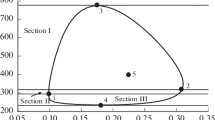Abstract
The problem of optimization of fed-batch fermentations using the substrate feed rate as the control variable is singular in nature. Previous approaches, including the boundary condition iteration method and transformation to a nonsingular problem using a different control variable, do not work well for solving optimization of systems governed by more than four differential equations. The applicability of a first-order conjugate gradient algorithm for optimizing fed-batch fermentations was tested for systems of varing complexity. This approach does not need any variable transformation ora priori knowledge of the control arc sequence. Constraints on the feed rate are handled in a simple and direct manner. The algorithm worked very well for three, four, and five-dimensional singular systems. The correctness of the optimal profile was judged by observing the variation in the sign of the gradient of the Hamiltonian. The gradient was found to be zero during the singular period and had the appropriate sign on the boundary arcs. The optimization method based on conjugated gradient approach can be complementary to the boundary condition iteration method for determination of the exact optimum profile.
Similar content being viewed by others
Abbreviations
- F:
-
fraction of plasmid-free cells, or feed rate L/hr
- g:
-
gradient of the Hamiltonian with respect to the control vector
- H:
-
Hamiltonian
- I:
-
a parameter defined in Eq. (13)
- K, k:
-
model parameters, or weight on the penalty function
- kd :
-
first order inactivation constant [hr1]
- p:
-
probability of forming a plasmid-free cell upon cell division
- R:
-
fraction of glucose that is channeled through the fermentative pathway, or metabolic flux [(g glucose)/hr. OD]
- S:
-
substrate concentration [g/L]
- s:
-
conjugate gradient direction
- t:
-
time [hr]
- V:
-
volume [L]
- w:
-
a boundary function defined by Eq. (6), (12)
- X:
-
cell mass concentration [g/L or OD]
- x:
-
state vector
- Yxy :
-
yield of respiratory pathway [OD/(g. glucose)]
- Yxj :
-
yield of fermentative pathway [OD/(g. glucose)]
- α:
-
a search parameter in the conjugate gradient method
- β:
-
a search parameter in the conjugate gradient method
- λ :
-
adjoint vector, or costate vector
- μ:
-
specific cell growth rate [hr]
- Π:
-
performance index, or objective function
- π:
-
invertase formation rate [KU/hr]
- ϕ:
-
gradient of Hamiltonian in singular problems
- +:
-
plasmid-containing cells
- -:
-
plasmid-free cells
- *:
-
optimal
References
San, K. Y. and Stephanopoulos, G.:Biotechnol. Bioeng.,26, 1261 (1984).
Parulekar, S. J. and Lim, H. C:Adv. Biochem. Eng. Biotech.,32, 207 (1985).
San, K. Y. and Stephanopoulos, G.:Biotechnol. Bioeng.,28, 356 (1986).
Modak, J. M., Lim, H. C. and Tayeb, Y. J.:Biotechnol. Bioeng.,28, 1396 (1986).
Lim, H. C., Tayeb, Y. J., Modak, J. M. and Bonte, P.:Biotechnol. Bioeng.,28, 1408 (1986).
Pyun, Y. R., Modak, J. M., Chang, Y. K. and Lim, H. C:Biotechnol. Bioeng.,33, 1 (1989).
Modak, J. M. and Lim, H. C:Biotechnol. Bioeng.,33, 11 (1989).
Menawat, A., Mutharasan, R. and Coughanowr, D. R.:AIChE. J.,33, 776 (1987).
Shimizu, H., Araki, K., Shioya, S. and Suga, K.:Biotechnol. Bioeng,38, 196 (1991).
San, K. Y. and Stephanopoulos, G.:Biotechnol. Bioeng,34, 72 (1989).
Lasdon, L. S., Mitter, S. K. and Warren, A.D.:IEEE Trans. Automatic Control.,AC-12, 132 (1987).
Pagurek, B. and Woodside, C. M.:Automatica.,4, 337 (1968).
Stutts, B.: Ph.D. Thesis, Purdue University, West Laffayette, IN 47907, USA.
Pontryagin, L. S., Boltyanskii, V. G., Gamkrelidze, R. V. and Mishchenko, E. F.: “The Mathematical Theory of Optimal Processes”, Interscience, New York (1962).
Bryson, A. G. and Ho, Y. C: “Applied Automatic Control”, John Wiley, New York (1975).
Patkar, A. Y.: Ph.D. Thesis, Purdue University, West Laffayette, IN 47907, USA (1972).
Sardonini, C. A. and DiBiasio, D.:Biotech. Bioeng.,29, 469 (1987).
Author information
Authors and Affiliations
Rights and permissions
About this article
Cite this article
Patkar, A., Lee, D.H. & Seo, JH. Development of a computer algorithm based on a conjugate gradient approach for optimization of fed-batch fermentations. Korean J. Chem. Eng. 10, 146–155 (1993). https://doi.org/10.1007/BF02705137
Received:
Accepted:
Issue Date:
DOI: https://doi.org/10.1007/BF02705137




